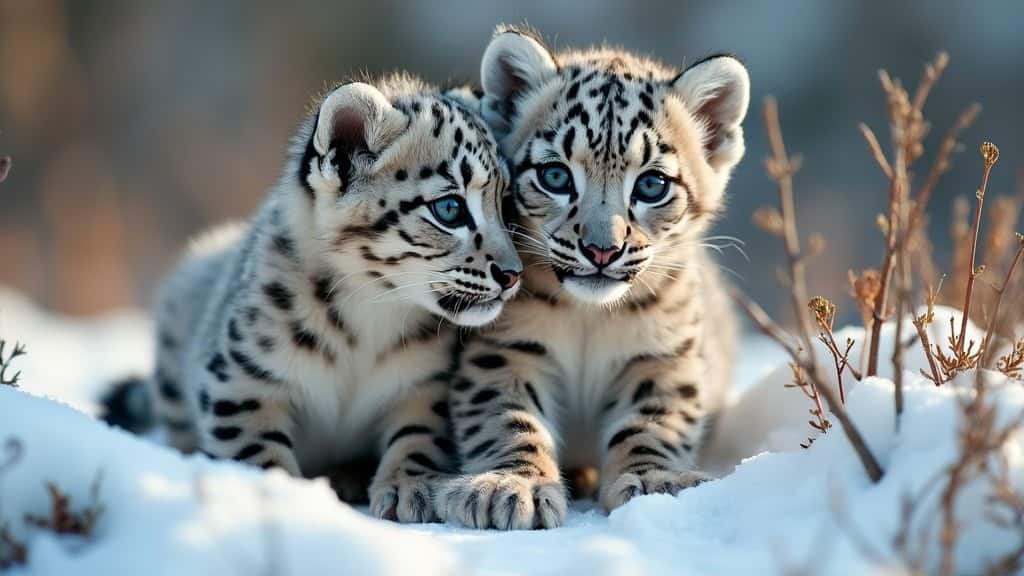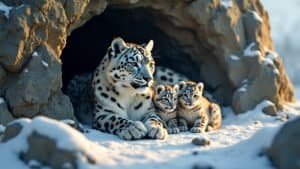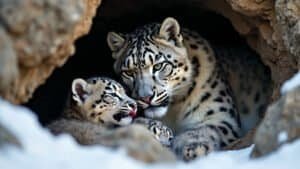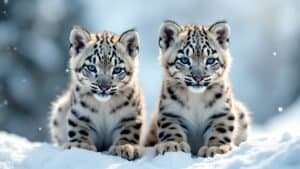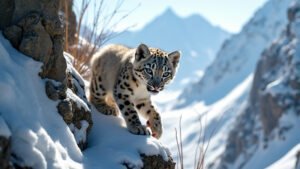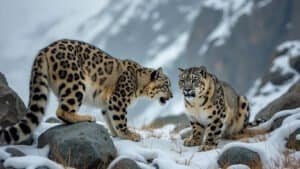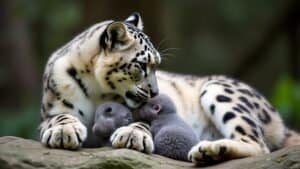Introduction
Snow leopard cubs, born in the rugged mountains of Central Asia, face numerous threats from the moment they enter the world. This article delves into the primary dangers that jeopardize their survival, including poaching, habitat loss, and natural predators
We’ll explore how human activities and climate change exacerbate these challenges and discuss ongoing conservation efforts aimed at protecting these vulnerable cubs. By understanding the obstacles snow leopard cubs face, we can better appreciate the importance of preserving this majestic species
The Impact of Poaching on Snow Leopard Cubs
Poaching poses a significant threat to snow leopards, particularly to cubs that are more vulnerable due to their size and dependence on their mothers
The illegal wildlife trade has long targeted snow leopards for their luxurious fur and body parts, which are highly valued in black markets. This illicit activity not only reduces adult populations but also disrupts the survival chances of cubs left without protection
The Demand for Snow Leopard Fur and Bones
Snow leopard fur is considered a luxury item, fetching high prices in illegal markets, particularly in East Asia. The demand for bones, used in traditional medicine, further incentivizes poachers
Cubs, though not directly targeted for their fur, often fall victim when their mothers are killed. The cubs, left orphaned and unable to fend for themselves, face almost certain death
The demand for snow leopard parts remains a driving force behind their poaching, with the species listed under Appendix I of CITES (Convention on International Trade in Endangered Species of Wild Fauna and Flora), indicating the highest level of protection against international trade
How Poaching Affects Snow Leopard Populations
Poaching has a devastating impact on snow leopard populations, which are already fragmented and isolated. When a mother snow leopard is poached, her cubs are left defenseless, often leading to their deaths from starvation or predation
Even if the cubs survive, the loss of their mother significantly reduces their chances of learning essential survival skills, such as hunting and avoiding predators. The cumulative effect of poaching is a reduction in genetic diversity, which can lead to inbreeding and further endanger the population’s long-term viability
Studies have shown that even a small number of poaching incidents can have a disproportionately large impact on population dynamics due to the slow reproduction rate of snow leopards
Measures to Combat Poaching
Efforts to combat poaching have intensified in recent years, with a focus on both international and local initiatives. Anti-poaching laws have been strengthened in countries where snow leopards are found, such as Mongolia, China, and India
Enhanced law enforcement, combined with better training and equipment for rangers, has led to more effective patrols in critical snow leopard habitats. Moreover, community-based conservation programs have proven successful, involving local people in the protection of snow leopards
These programs often include education about the ecological importance of snow leopards and providing alternative livelihoods to reduce reliance on poaching. The Snow Leopard Trust, a leading conservation organization, works closely with communities to create sustainable economic opportunities, such as handicraft production, which directly benefits snow leopard conservation
Additionally, international cooperation plays a crucial role in combating poaching. The Global Snow Leopard and Ecosystem Protection Program (GSLEP), an initiative launched in 2013, brings together 12 countries within the snow leopard range to address poaching and other threats through collaborative efforts
The program emphasizes the importance of transboundary cooperation, as snow leopards often roam across national borders. By uniting countries and organizations, GSLEP aims to ensure the long-term survival of snow leopards and their habitats
Despite these efforts, poaching remains a persistent threat. Continuous monitoring, law enforcement, and community engagement are essential to reduce the impact of poaching on snow leopards, particularly on vulnerable cubs
The ongoing battle against poaching highlights the need for sustained and coordinated conservation efforts to protect this iconic species and ensure that future generations of snow leopards can thrive in their natural habitats
Habitat Loss and Its Effects on Snow Leopard Cubs
Habitat loss is one of the most significant challenges snow leopards face, directly threatening the survival of cubs. As human populations expand, snow leopard habitats are increasingly encroached upon, leading to fragmentation and degradation of the environments these big cats rely on
Snow leopard cubs, dependent on specific habitat conditions for shelter and food, are particularly vulnerable to these changes
The Role of Human Encroachment
Human activities such as agriculture, livestock grazing, and infrastructure development have progressively encroached on the snow leopard’s natural habitat. These activities not only reduce the available space for snow leopards but also disrupt their prey base
As humans settle in higher altitudes, the traditional habitats of snow leopards are shrinking, forcing them into closer proximity with human populations. This proximity increases the likelihood of human-wildlife conflict, where snow leopards may prey on livestock, leading to retaliatory killings by herders
For snow leopard cubs, human encroachment means reduced access to safe dens and fewer opportunities to learn hunting skills in a secure environment. The encroachment also leads to increased competition with livestock for food sources, which further diminishes the cubs’ chances of survival
Studies have shown that habitat fragmentation, driven by human activity, has resulted in a significant decline in snow leopard populations, making it harder for cubs to grow up in a stable environment
The Impact of Infrastructure Development
Infrastructure projects such as roads, railways, and mining operations pose a serious threat to snow leopard habitats. These developments often slice through critical snow leopard territories, fragmenting the landscape and isolating populations
For cubs, this isolation can be deadly, as it reduces their genetic diversity and increases the risk of inbreeding. Additionally, infrastructure development often brings more humans into snow leopard territory, increasing the chances of poaching and human-wildlife conflict
One of the most concerning aspects of infrastructure development is its impact on migration routes. Snow leopards are known to roam over large areas, and their cubs depend on these vast ranges to learn essential survival skills. When infrastructure projects disrupt these routes, it forces snow leopards into smaller, confined areas, which may not support the prey density required for cubs to thrive
The International Union for Conservation of Nature (IUCN) has highlighted that infrastructure development is one of the leading causes of habitat fragmentation for snow leopards, emphasizing the need for wildlife corridors and other mitigation strategies
Consequences of Habitat Fragmentation
Habitat fragmentation has severe consequences for snow leopard cubs, leading to decreased access to prey, increased human conflict, and heightened vulnerability to environmental changes
Fragmented habitats often cannot support the diverse ecosystems snow leopards need to survive, leading to a reduction in prey species. For cubs, this means less food and a lower chance of reaching adulthood
Moreover, fragmented habitats make it harder for snow leopard populations to interbreed, leading to genetic bottlenecks. Genetic diversity is crucial for the resilience of any species, and its reduction can make snow leopards more susceptible to disease and environmental changes. Cubs born into these fragmented populations may face increased mortality rates due to these compounded pressures
Conservationists are working to address habitat loss through various means, including the creation of protected areas, habitat restoration, and promoting sustainable land-use practices
Projects like the Snow Leopard Trust’s community conservation programs aim to balance the needs of local people with the conservation of snow leopard habitats. By involving local communities in conservation efforts and offering them alternative livelihoods, these programs help reduce human encroachment and the resulting habitat loss
Natural Predators and the Threat to Snow Leopard Cubs
While snow leopards are apex predators, their cubs are vulnerable to a range of natural threats. Predation by other large carnivores, competition for food, and the harsh conditions of their mountainous habitats all pose significant risks to the survival of young snow leopards
Understanding these natural threats is crucial for developing strategies to protect cubs during their most vulnerable stages of life
Identifying the Main Predators
Although snow leopards are formidable hunters, their cubs are at risk from several other predators in their high-altitude habitats. Large birds of prey, such as golden eagles, are known to pose a danger to very young cubs, especially when they are left alone while the mother hunts
These birds have been observed preying on small mammals and even young ungulates, making snow leopard cubs a feasible target
Other carnivores, including wolves and other big cats like lynxes, can also pose a threat, particularly in regions where their territories overlap with snow leopards
These predators may target cubs if they come across them, especially if the mother is not nearby to defend them. The competition among these predators for limited prey can lead to increased predation pressure on snow leopard cubs
The Impact of Predator Competition
The mountainous regions that snow leopards inhabit are home to a variety of other large carnivores, leading to competition for food resources. This competition can indirectly impact snow leopard cubs by reducing the availability of prey species such as blue sheep and ibex
When prey is scarce, snow leopard mothers may have to travel farther and expend more energy to find food, leaving their cubs unattended for longer periods
Increased competition can also lead to direct confrontations between snow leopards and other predators. For instance, wolves and snow leopards sometimes compete for the same prey, and while adult snow leopards can usually defend themselves, their cubs are much more vulnerable
Such encounters can result in the death of cubs, either from predation or from being left alone for extended periods while the mother is engaged in defending her territory
Defense Mechanisms of Snow Leopard Mothers
Snow leopard mothers employ several strategies to protect their cubs from predators. One of the primary tactics is selecting den sites that are difficult for predators to access
These dens are often located in remote, rugged terrain with ample cover, such as caves or rocky outcrops. By choosing these secluded locations, mothers minimize the risk of other predators discovering their cubs
Another defense mechanism is the mother’s constant vigilance and readiness to defend her cubs. Snow leopard mothers are known to be fiercely protective, and they will aggressively confront much larger predators to safeguard their young. The mother’s presence alone can often deter potential threats, as few animals are willing to risk a confrontation with an adult snow leopard
Despite these protective measures, snow leopard cubs remain at high risk during the early months of their lives. The combination of natural predation, competition, and the challenging environment they are born into means that only a small percentage of cubs survive to adulthood
Conservation efforts aimed at reducing these threats include habitat protection, ensuring sufficient prey availability, and monitoring predator populations to prevent imbalances that could lead to increased predation pressure on snow leopard cubs
The Role of Climate Change in Snow Leopard Cub Mortality
Climate change is increasingly becoming a critical factor affecting the survival of snow leopards and their cubs. The rising temperatures and shifting weather patterns in the high-altitude regions where snow leopards live are leading to a range of ecological disruptions
These changes are impacting the availability of prey, altering habitats, and increasing the frequency of extreme weather events, all of which pose significant challenges to the survival of snow leopard cubs
How Climate Change Alters Snow Leopard Habitats
Climate change is causing significant alterations in the habitats of snow leopards, particularly in the mountainous regions of Central and South Asia. As temperatures rise, the treeline in these areas is gradually moving upward, leading to a shift in the distribution of species that snow leopards rely on for food
The melting of glaciers and reduction in snow cover are also impacting the landscape, reducing the availability of suitable den sites that offer protection for cubs from predators and harsh weather
In addition, the warming climate is causing a reduction in the extent of alpine meadows, which are crucial for supporting herbivore populations like blue sheep and ibex—primary prey for snow leopards. As these meadows shrink, the prey species may decline in number, leading to food scarcity for snow leopards. For cubs, this means less food availability, which can result in malnutrition or starvation
The changing habitat conditions also force snow leopards to range over larger areas in search of food, increasing the likelihood of human-wildlife conflicts and exposing cubs to greater risks
Impact on Prey Availability
The impact of climate change on the prey species of snow leopards is profound and directly affects the survival of their cubs. As the distribution and abundance of key prey species like blue sheep, ibex, and argali are influenced by climate change, snow leopards must adapt to these shifts
In some cases, this might mean moving to higher altitudes or different areas, which can be challenging for young cubs who are not yet skilled hunters or physically robust enough to handle long-distance travel
The decrease in prey availability can lead to increased mortality among snow leopard cubs due to starvation or the need for the mother to leave them alone for extended periods while she hunts over larger territories
Additionally, when prey becomes scarce, snow leopards may turn to livestock as an alternative food source, which can lead to retaliatory killings by local herders. This further endangers cubs, who may lose their mothers to such conflicts
Research has shown that changes in prey populations driven by climate change are one of the most critical factors affecting the long-term survival of snow leopards. A study published in Biological Conservation highlighted the potential for prey scarcity to drive snow leopards into more isolated and less suitable habitats, which could severely impact cub survival rates
Adaptation Challenges for Snow Leopard Cubs
Adapting to the rapidly changing environment poses significant challenges for snow leopard cubs. Unlike adult snow leopards, which may have the experience and physical capability to cope with environmental shifts, cubs are less adaptable
They rely heavily on their mothers for food, protection, and learning essential survival skills. As climate change disrupts these processes, cubs may struggle to reach maturity
The increasingly unpredictable weather patterns associated with climate change, such as heavy snowfall, unseasonal storms, or prolonged droughts, can also directly threaten the lives of snow leopard cubs
Harsh weather can destroy den sites, making cubs more vulnerable to exposure and predation. Additionally, extreme weather events can reduce the availability of prey, further compounding the survival challenges faced by cubs
Conservation efforts aimed at mitigating the impacts of climate change on snow leopards include habitat restoration, protecting critical migration corridors, and working with local communities to reduce human-wildlife conflict
By preserving and restoring habitats, ensuring the availability of prey species, and promoting climate resilience in local communities, these efforts can help improve the survival prospects of snow leopard cubs in the face of a changing climate
Conclusion
Snow leopard cubs face a myriad of threats from the moment they are born, with poaching, habitat loss, natural predators, and climate change being the most significant. Poaching remains a persistent issue, driven by the high demand for snow leopard fur and bones, which not only reduces adult populations but also leaves cubs vulnerable and defenseless
Habitat loss, primarily due to human encroachment and infrastructure development, further exacerbates the challenges snow leopard cubs face by fragmenting their environments and reducing prey availability. Natural predators, combined with competition for limited food resources, pose additional risks, especially in the cubs’ early months
Lastly, climate change is reshaping the high-altitude habitats snow leopards depend on, leading to food scarcity and increased environmental stress. To ensure the survival of snow leopard cubs, comprehensive and coordinated conservation efforts are essential, focusing on combating poaching, preserving habitats, managing predator populations, and mitigating the impacts of climate change
Through these efforts, we can help protect this iconic species and secure a future for snow leopard cubs in the wild
